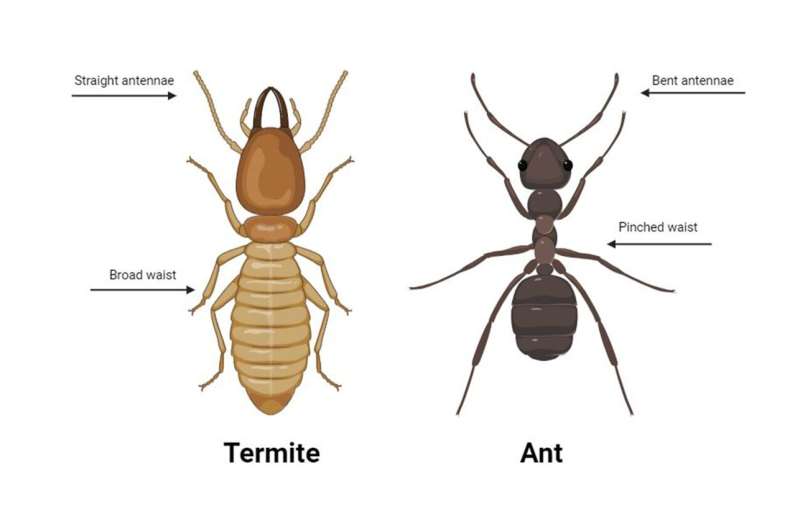This article has been reviewed according to Science X's editorial process and policies. Editors have highlighted the following attributes while ensuring the content's credibility:
fact-checked
trusted source
proofread
White ants: The Earth's backboneless backbone

The first thoughts that probably come to mind when you read the words "white ant" are images of house destruction, wood damage, pest control, and spending money! While white ants are in fact a major structural and agricultural pest, they are among the most important organisms to maintain ecosystem health. Without them, habitats like rainforests would likely fail and animals depending on termites would die.
What is a white ant?
Termites—commonly referred to as white ants—are not actually ants at all, they are essentially very specialized and social cockroaches. Often living in nests of well over 1 million individuals, termites have extremely complex social lives and enormously intricate living environments. They are so socially and structurally complex that researchers developed mathematical equations to understand how termites dig and forage.
White ant nests are described as "one of the architectural wonders of the living world" and appear in/on trees, soil, power poles and above ground in giant mounds that can stretch 2 meters high. Recent research has found that some of these mounds are more than 30,000 years old and still occupied today!
Out of approximately 300 Australian species (including 90 undescribed), only a handful are recognized as pests in Australia. In fact, in tropical forests, white ants, or termites are by far the most ecologically important invertebrate decomposers. With the help of other microorganisms, white ants release nutrients back into the environment, helping both plants and animals survive.
What do white ants look like?
With more than 2,000 termite species in the world, and multiple feeding/nesting groups, it is unsurprising that white ants can look very different from one another. Even individuals of the same species that occupy the same nest can look completely different depending on their role as king, queen, worker, soldier or alate (more to come).
Nevertheless, white ants are generally distinguished by their soft, pale-colored bodies (ranging from brown to white), straight antennae, and broad waist—not to be confused with ants, which have pinched waists and bent antennae.
Do white ants fly?
Yes and no. Not all white ants in a colony can fly—and those that do, only remain winged for a day or two. This ability is dependent on their role (also known as caste) in a nest. Different worker castes (kings, queens, soldiers, workers, or alates) have varying purposes, and therefore different body features.
Sexually developed white ants, known as alates are winged when mature, with the purpose of flying out of the nest to establish a new colony, where they'll become kings or queens (not to be confused with the coronation process with which we are familiar).
This phenomenon, known as "social swarming," typically occurs on warm, humid evenings in spring or summer. You might be familiar with the annual swarms, where some unfortunate, poorly navigating white ants might end up in your drink or dinner.
Alates have two pairs of temporary wings, which fall off very soon after landing, after which the termite white ant will burrow and become the newly appointed termite royalty: king or queen. After these swarms, you will likely see hundreds, if not thousands of discarded wings in windowsills, tiles, crevices and door tracts—just hopefully not in your home.
How do you know if you have white ants in your home?
Despite only about 10% of known global termite species being considered pests, the damage caused can be extremely severe and costly. The presence of alates (flying termites) around a home or property indicates that a mature nest is relatively close and expanding. Even if you haven't seen alates, it is recommended to have annual termite inspections by a registered pest control company.
There are other indicators to be aware of which can potentially highlight a problem in your home.
Visible wood and structural damage, hollow sounding wood, and the presence of termite poo (frass) can be indicative signs of a white ant invasion.
Small mud tunnels and patches may also be present on the interior and exterior walls of houses, which are built and used for protection and airflow mitigation while the termites move around. Interestingly, some white ants bang their heads on nest walls as a form of auditory communication.
Research has indicated that tapping in white ants may be a way to communicate alarm to nestmates. So, if you hear a soft, yet rapid rattling sound in your walls, it's best to call a pest control company rather than your local exorcist.
How to get rid of white ants
Termite treatments vary with the type of termites present, i.e., subterranean, drywood or dampwood. To control termites, you need to find out what kind they are, find their nests, and choose the right way to get rid of them. No one method works for all termites, but you can do a few things.
As mentioned earlier, annual termite inspections are advised. You should use wood that termites don't like or is treated to resist them, and add chemical and physical barriers in the soil around buildings to keep termites away. However, consulting with a registered pest control company is highly recommended as the first and most important step.
Despite their notoriety as pests, white ants are essential to the natural world, performing critical roles on all continents except Antarctica. Their dual reputation as pests and ecosystem engineers highlights their sheer importance.
While white ants are essential for maintaining ecological balance, their potential for destruction requires vigilant management and control. An understanding of white ants is essential for preserving natural ecosystems and protecting human infrastructure and investments.
Provided by University of the Sunshine Coast




















